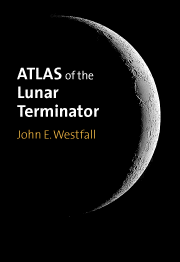Book contents
- Frontmatter
- Contents
- Preface and Acknowledgements
- dedication
- Section I Terminator Observation and Interpretation
- Chapter 1 Observing the Moon and Its Terminator
- Chapter 2 The Moon's Surface Features
- Section II Atlas
- Appendix: Lunar Physical Ephemeris, 2000-2010
- Bibliography
- Mosaic Feature Index
- Subject Index
- Individual Features Index
Chapter 2 - The Moon's Surface Features
Processes and Periods
from Section I - Terminator Observation and Interpretation
Published online by Cambridge University Press: 05 February 2015
- Frontmatter
- Contents
- Preface and Acknowledgements
- dedication
- Section I Terminator Observation and Interpretation
- Chapter 1 Observing the Moon and Its Terminator
- Chapter 2 The Moon's Surface Features
- Section II Atlas
- Appendix: Lunar Physical Ephemeris, 2000-2010
- Bibliography
- Mosaic Feature Index
- Subject Index
- Individual Features Index
Summary
The Visibility of Features
The Moon bridges the gap between the terrestrial landscapes we observe at first hand and the celestial objects we look at from afar. Over one hundred times as close as the nearest planet, we can see features on the Moon with the naked eye that would require a telescope to see on any other body. With a telescope, our resolution of detail on the Moon is comparable to that of spacecraft images of the planets and their satellites.
It is thus not surprising that the Moon has been our training ground for planetary science. The phases of the Moon demonstrated that the Moon was an approximately spherical world like the Earth itself. Beyond this, the first features noticed upon the Moon were its dark tonal or albedo features, generally called maria or “seas.” Shadows or terminator extensions giving proof of the existence of lunar relief features are at the limits of naked-eye visibility, such as terminator “dents” caused by the crater Clavius or the Montes Apenninus. Theories about processes significant for the other solid bodies of the solar system, such as impact craters and basin formation, and crustal differentiation, were first developed for the Moon before they were applied to farther worlds.
Lunar landforms are obvious in any telescope and are the most prominent type of feature near the terminator, where tonal differences are obscured by the play of light and shadow. The tonal and color differences of the Moon's surface, along with their changes with lighting, are second only to surface samples returned to Earth as a source of information about the mineralogical composition of the Moon.
- Type
- Chapter
- Information
- Atlas of the Lunar Terminator , pp. 26 - 56Publisher: Cambridge University PressPrint publication year: 2000



